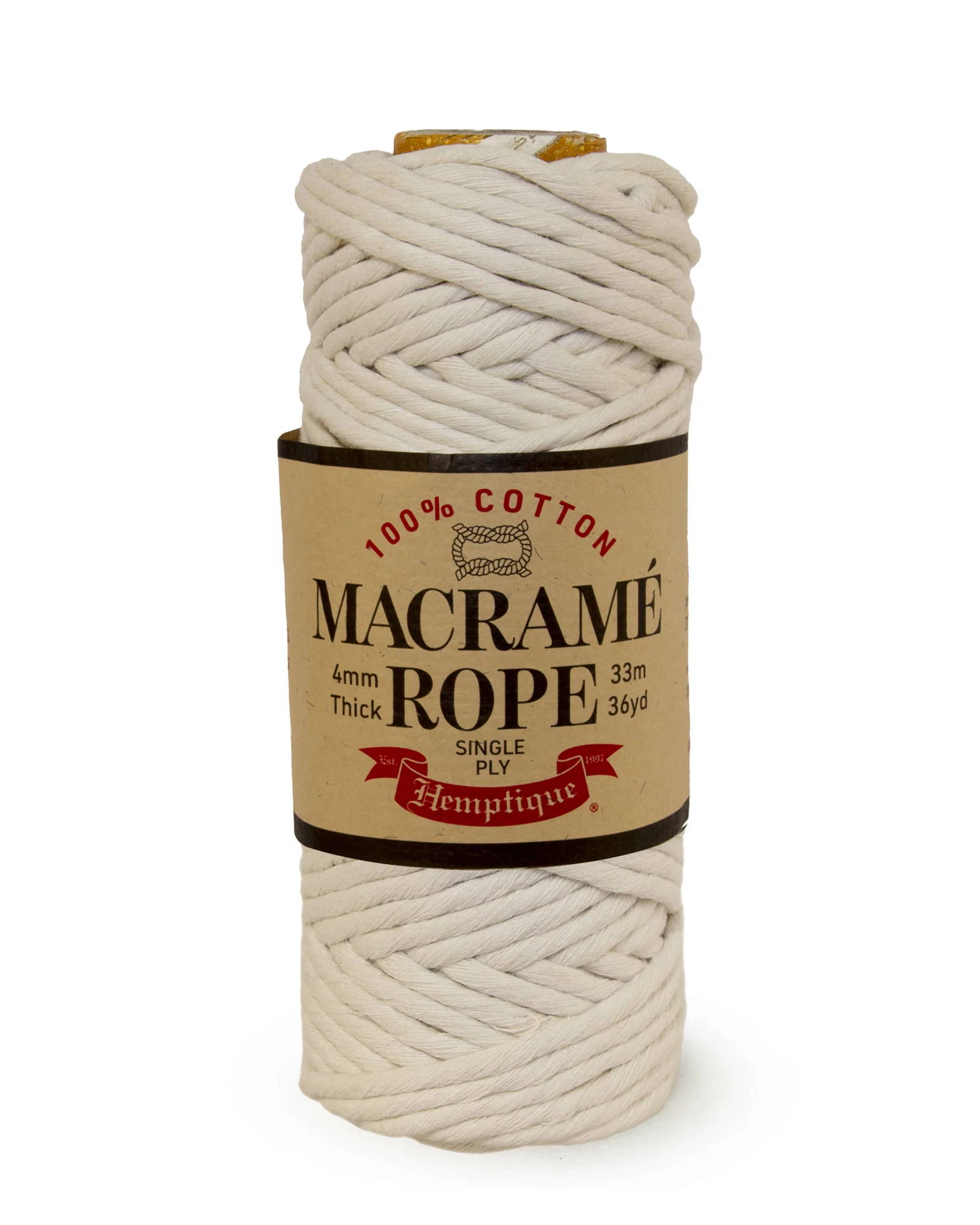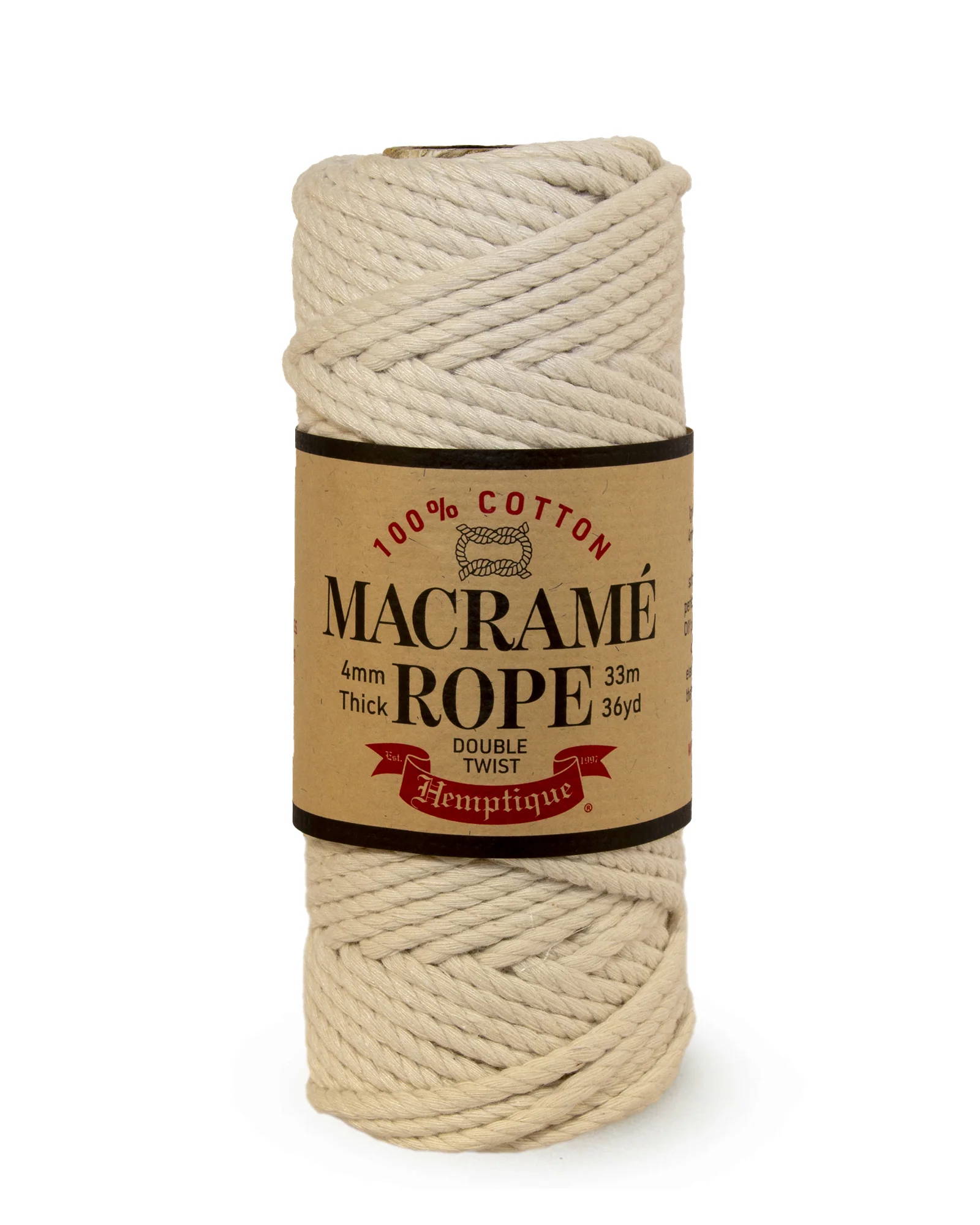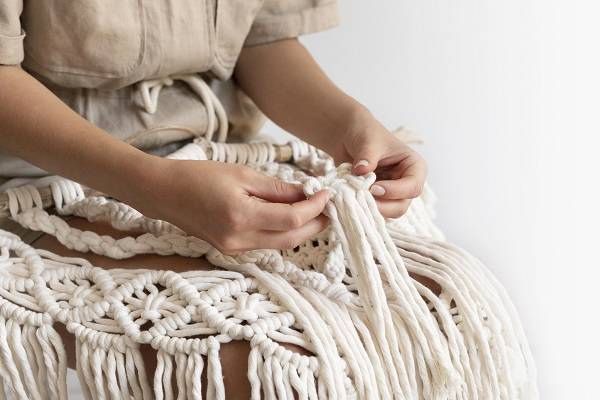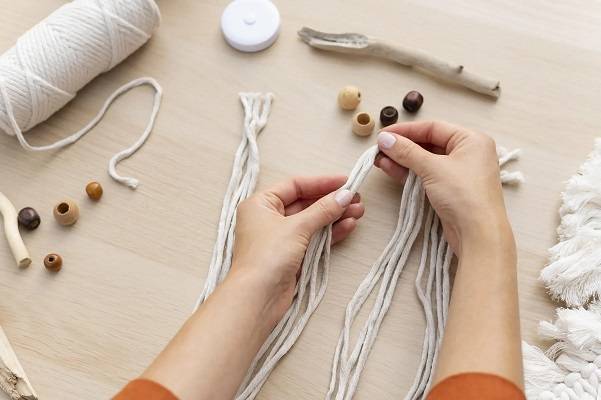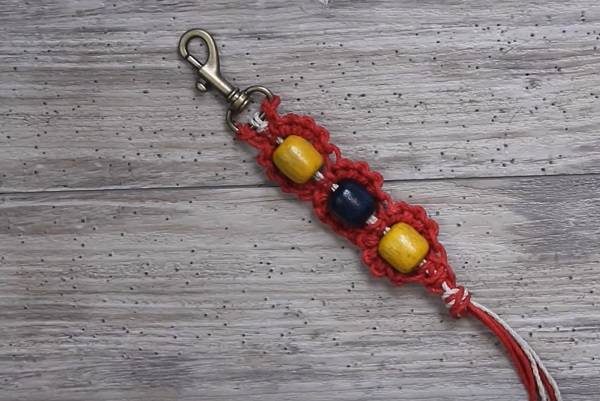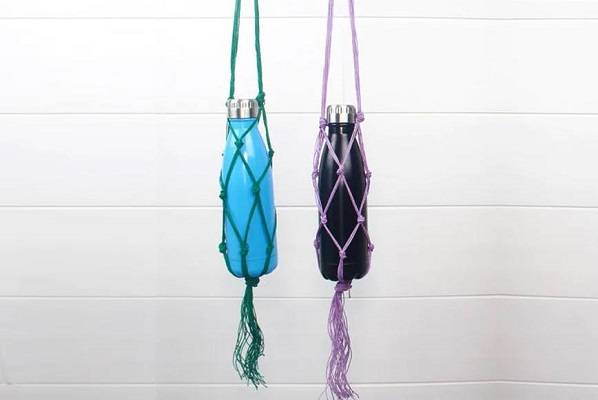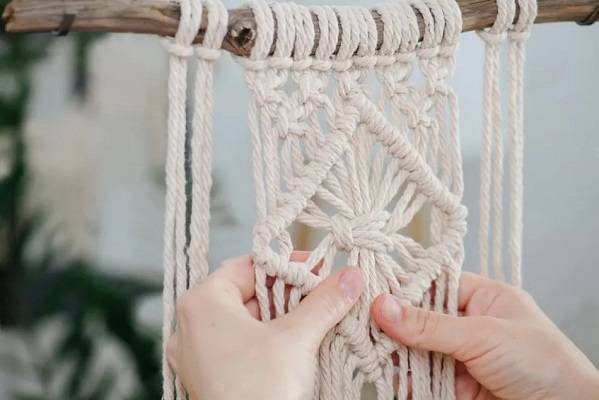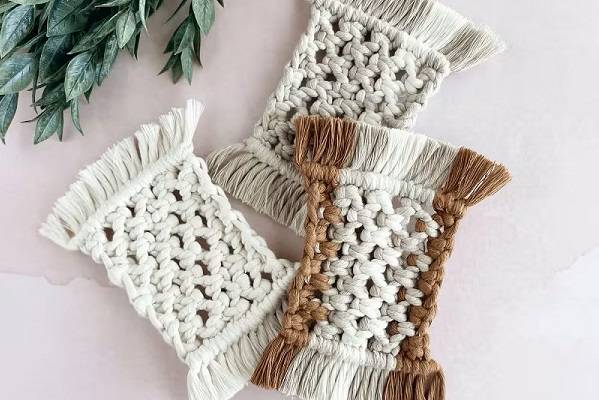Cotton Macrame Cord: The Best Natural Fiber for DIY Projects?
Why cotton macrame cord is a favorite among crafters—compare it to other fibers and pick the best fit for your next DIY.

Innovation & Quality
Developing and supplying premium-quality, sustainably grown, consumer products
100% Natural
Organically Grown and Ethically Sourced
hemp and other natural fiber products
Shipping
We offer fast shipping
Your order out within 1-3 days
Wholesale
Visit our wholesale portal to register or login to your account
Macrame cord is the number one supply needed for any knotted work of art. It's the key ingredient for crafting intricate and unique designs in fashion, art, and home décor. Today, there are many types of cords available, each with its own unique properties, from soft and flowy to durable and textured, so picking the right one is essential to bringing your ideas to life. In fact, the choice of cordage determines how good your DIY wall hanging, bookmarker, jewelry, or plant holder will turn out in the end.
In the article below, you’ll learn more about the properties and benefits of using cotton fiber for macrame projects. We’ll discuss key properties such as thickness and strength, helping you pick the right product that suits your design vision. Whether you are a beginner or an advanced crafter, this article will provide insights about the natural fiber that enables you to create gorgeous, durable handmade items.
Shop Macrame Cotton Rope at Hemptique – Perfect for Pros & Beginners!
Hemptique is a renowned manufacturer of eco-friendly art & craft supplies made of top-grade natural materials. Our fiber product line includes products of superior quality that align with eco-conscious living principles, such as threads, cords, yarn, and twine, ideal for creating unique, beautiful, and durable designs using various techniques. For macrame enthusiasts, we offer 100% Egyptian cotton cord in two different varieties – Single-ply Egyptian cotton macramé rope and Double twist Egyptian cotton macramé rope. Available in 4mm and 6mm, and natural and white colors, they are soft, sturdy, and durable, suitable for all kinds of DIY projects, including personal accessories (keychains, purses, net bags), home décor (wall hangings, feathers, plant hangers, macrame rainbows), jewelry (belts, bracelets, necklaces), furniture (hammocks, swings, poufs, deckchairs), and clothing (dresses, skirts, tops). To fully cater to all crafters’ needs, we offer wholesale opportunities for retailers, small businesses, schools, workshops and anyone else looking to add cotton cord to their offerings. To find out more about discounts, competitive pricing, flexible ordering options, and fast shipping, call us at 760-602-4864 ext. 403 and 405, apply for a wholesale account or send in a bulk request order.
Cotton Fiber – An Overview
Cotton fiber is sourced from the seed hairs (trichomes) of plants belonging to Gossypium (cotton plant). The fibers are naturally soft, breathable, and durable single cell structures with the following characteristics:
Natural, cellulosic textile fiber
Soft and breathable
Natural crimp improves knot security
- Long, fine fibers are easy to manipulate
Resists static electricity build up
Becomes stronger when wet
- Doesn’t contain irritants, gentle to sensitive skin
5 Reasons Why Cotton is Great for Macrame Projects
The reason why many macrame artists choose cotton cord is its unique fiber structure. It holds knots well, it’s soft, strong, and flexible, but it’s also biodegradable, making it preferred choice for eco-conscious crafters.

1. Easy to work with
As one of the softest fibers in the world, it’s easy and comfortable to work with. Unlike other natural fibers (jute, sisal), it’s not rough and does not cause hand fatigue, scratches, or friction burns. Since macrame requires a lot of knotting and re-knotting, it’s crucial to use fibers that are gentle on hands and don’t cause any discomfort. For instance, if you were working on a large macrame project with hundreds of knots, using jute or sisal could cause skin irritation, while cotton enables you to work comfortably for longer.
2. Holds knots well
Cotton fibers have just enough texture to hold knots securely in place without slipping. The entire craft relies on various types of secured macrame knots to create durable, structural design, so avoid using slippery fibers like synthetics. Cotton cords, especially multi-ply braided ones, can withstand heavier loads without slipping due to secured knots.
3. Easy to dye
Cotton fibers are hollow, they absorb dyes better than synthetic fibers. The natural moisture absorbency allows for excellent color customization with soft, pastel, deep, and vibrant colors, without fading quickly. Cotton soaks up the dye evenly, unlike synthetics, which may repel dye and cause patchy areas.
4. Eco-friendly choice
Cotton is 100% biodegradable, meaning it naturally decomposes over time, thus minimizing environmental waste. It supports ethical crafting by reducing microplastic pollution. For hobbyists and artisans who want even more sustainability, organic and recycled cotton is available.
5. Very versatile – suitable for various styles
Cotton cords are offered as single-strand, multi-plied, twisted, and braided, in various thicknesses, from fine, thin jewelry cords to chunky, thick ropes. This makes it fit for classic, boho, and modern macrame styles, for both small-scale and large-scale DIY projects.
Macrame Cord, Rope, and Thread – Which One is Best for Your Project?
Although these terms are often used interchangeably, there are some differences in their properties and intended use.
| Features | Best uses | |
|---|---|---|
| Cotton thread | Very thin | Micro-macrame, jewelry making, fine detailing |
| Cotton cord | Soft & flexible, offered as single-strand, twisted, and braided | Commonly used for structural look and strength |
| Cotton rope | Thick & sturdy, offered as twisted or braided | Furniture, large projects, home décor |
How to Choose the Right Thickness
Cord’s thickness is essential because it directly impacts the item’s strength, flexibility, and appearance. Understanding how diameter affects overall performance will help you find the best cord for your specific project.
Cotton macrame cords typically range from 1mm to 12mm, with each diameter suitable for specific use. In general, thin cords are used for fine, detail work, and smaller projects, while thicker cords are used to create chunky knots.
| Features | Level of detail | Application | Avoid for | |
|---|---|---|---|---|
| 1mm – 3mm | Fine, thin, and flexible fibers | Small projects, delicate designs with small knots | Jewelry making, keychains, intricate patterns, lightweight pieces | Large projects, heavy-bearing designs |
| 4mm – 6mm | Beginner-friendly, flexible, but thicker; most versatile cord | Good for detailed and structural work; easy to knot | Wall hangings, home décor, plant hangers, garlands | Holding heavy weights (furniture, hammocks) |
| 8mm + | Thick, chunky, less flexible, holds heavy weight | Large installations with large, visually striking knots | Large projects, rugs, furniture (room dividers, headboards, swings) | Small designs |
What is Ply?
Ply denotes the number of individual strands twisted together to form a single cord. The larger the number of strands (plies), the stronger the cord.
- 1-Ply (Single strand) – This type of cord is made by twisting many fibers into a single strand. It comes in sizes from 1mm – 5mm and it’s the softest cord available. It’s ideal for delicate flowing and fringing designs with tassels, clothing, jewlery, and wall hangings. The downside is that it frays easily.
- 3-Ply (Triple twisted) – This is a multi-ply rope, made of 3 strands twisted together in three parts to form one cord. It’s the most versatile type and most commonly used for crafting because it holds shape well, it provides enough structure and is easily manageable. It can be used for handmaking plant hangers, furniture, hanging organizers, table runners, clothes, home décor, etc.
- 4-Ply+ (Twisted or braided) – This is the strongest option because it’s made from four or more strands twisted or braided together. Braided rope is made by braiding or intertwining 8 to 10 strands into a tube-like braid. It holds heavy loads well, it doesn’t fray, it doesn’t stretch, and it’s exceptionally durable. Use it for large macrame projects that require strength, minimal stretch, and maximum durability.

Cotton vs. Other Popular Macrame Fibers
If you are not sure which material to use for your net macrame project, here’s a comparison table including main features of several popular materials. It should help you have a better understanding of how cotton, hemp, jute, and synthetic will perform.
| Cotton | Hemp | Jute | Synthetic | |
|---|---|---|---|---|
| Strength & durability | Medium to high strength | Very strong & long-lasting | Strong, but weak longevity due to brittleness | Very strong & durable |
| Knot strength | Very good | Excellent | Very good, but stiff | Tends to unravel |
| Ease of handling | Very easy to work with; beginner-friendly | Requires some skill | Easily manageable | Slippery; requires good control and skill |
| Softness | Very soft | Medium softness | Rough | Lacks natural feel |
| Texture | Smooth & very soft, comfortable | Softens with use | Coarse | Slick & slippery |
| Flexibility & drape | Beautiful drape; very easy to shape | Slightly stiffer than cotton; holds structure well | Stiff, but manageable | Very flexible |
| Eco-friendliness | 100% Biodegradable & sustainable | One of the most sustainable fibers | Biodegradable | Not biodegradable |
| Project ideas | DIY clothing, accessories, jewelry, wall hangings, home décor, bookmarks | Sturdy structures, plant hangers, furniture, home décor, Christmas ornaments | Rope crafts, rustic décor, bags, | Best for outdoor use and wet (marine) environments |
Recommended Products
Find your perfect cord and bring your ideas to life with Hemptique’s high-quality cotton cords, tailored to meet all your needs. Our products are designed to allow you an enjoyable and smooth crafting experience, and are suitable for both beginners and advanced crafters.
Single Ply Egyptian Cotton Macramé Rope
Our single-ply cotton macrame rope is crafted from 100% Egyptian cotton, using an eco-friendly manufacturing process. It’s fine, thin, and soft, yet durable, making it ideal for smaller projects, intricate designs, softer detailing, and boho look. It unravels beautifully to create lovely wave fringe needed for feather designs. It’s great for novice macrame artists and advanced enthusiasts.
- Material: 100% Egyptian cotton
- Thickness & length: 4mm 33m (36yds) & 6mm 20m (22yds)
- Colors: Natural and white
- Best use: Detailed tapestries, small wall hangings, macrame jewlery, keychains
Double Twist Egyptian Cotton Macramé Rope
Hemptique’s double-twist cotton Macrame rope is made from 100% premium Egyptian cotton. It’s ideal for a wide range of projects because it’s highly durable and strong, yet soft and flexible. It’s easy to manipulate and crafted to work seamlessly when knotting complex designs that require more structure.
- Material: 100% premium Egyptian cotton
- Thickness & length: 4mm, 33m (36yds) & 6mm 20m (22yds)
- Colors: Natural and white
- Best use: plant holders, wall hangers, dream catchers, chunky macrame pieces
Conclusion - Start Your First Macrame Project with Cotton Cord
As you can see, cotton is one of the best fibers for macrame due to its softness, strength, versatility, durability, and sustainability. It’s natural, eco-friendly, easy on hands, comfortable to work with, and holds knots securely. It’s available in several thicknesses and styles – single-strand, 3-ply, twisted, or braided, making it suitable for everything from jewelry making and keychains to Christmas ornaments and large-scale furniture macrame. Now that you have better understanding on cotton cord and how it can affect your macrame project, it's time to take the first step start planning your first macrame project.
Knowledge Base
If you haven’t picked your first craft project yet and need inspiration, check out our Knowledge Base. It’s a collection of great beginner-friendly ideas, tutorials, simple guides, tips, and tricks on how to improve your skills. You will also find lots of valuable information on go-to craft supplies, useful tools, various techniques, product overviews, and free knotting patterns. Apart from macrame, this digital info hub covers other crafts like jewlery making, weaving, knitting, crocheting, bookbinding, string art, embroidery, leather sewing, and so much more. Our mission is to support the entire crafting community, regardless of their craft. We hope to empower artisans by sharing free digital resources on various handicrafts, suitable for all ages and skill levels. Last but not least, we are promoting and highlighting the importance of eco-friendly and sustainable crafting and living.
Popular Questions Answered
1. How do I know if cotton cord is of high quality?
Top-quality cords are characterized by smooth texture, even thickness, and low shedding rate. Plus, long-staple fiber is more durable than short-staple (which tends to break easily). Consider purchasing from notable brands like Hemptique, to ensure you have quality products.
2. Can I use cotton even for large DIY macrame projects?
Certainly! Just make sure you are using the right type of rope, with enough strength to support and hold the structure. It’s recommended to avoid thin single-strand options, as they don’t have enough strength for larger installations. Twisted cords, 6mm – 10mm thick, are suitable for canopies or curtains, while 8mm-12mm ropes are perfect for making headboards and large room dividers.
3. Is there a way to prevent cotton from fraying while I craft?
Single-strand cotton cords are very prone to fraying during knotting or when left unfinished. In order to prevent this from happening, before cutting, wrap rope ends with masking tape and use glue (or clear nail polish) to seal the fibers. If you are using twisted or braided cord, twist the ends firmly before cutting.
4. My cotton rope sheds a lot. What should I do?
Certain low-quality or loosely spun ropes tend to shed a lot of lint and dust. To minimize the amount of lint, wash before use and use lint rollers (or vacuum) to remove loose fibers. If you want to avoid this in the future, choose high-quality cordage.
5. Is there a way to prevent yellowing over time?
As cotton is a natural fiber, it tends to change its properties over time. Such occurrence is yellowing due to sunlight exposure or natural aging. You can prevent (or postpone) this from happening by keeping the item away from direct sunlight. If you want to brighten the fabric, it’s good to hand-wash using mild soap and baking soda from time to time. Remember to store your fiber craft supplies in a dark, dry, and cool place.
6. Can I use cotton cords for outdoor projects?
Yes, you can use it for outdoor DIY projects; however, you must take precautionary measures to ensure durability and longevity of your finished product. As cotton absorbs moisture, you have to pre-treat the cord with weatherproof sealant, such as beeswax or fabric sealant.
7. Does cotton cord stretch over time?
Cotton is natural fiber that stretches over time, especially when holding weight (plant hangers) or when exposed to humidity. Consider using braided or twisted cords because they are stronger than single-strand. You could also double up cords for extra support. If your handmade piece has already stretched, wash it in warm water, reshape it, and let air dry.
8. Can I wash macrame items made of cotton cord?
Absolutely! To maintain item integrity, follow the recommended care instructions that include spot cleaning using with mild soap and cold water, gentle hand washing and air drying. Avoid harsh detergents and hot water in order to avoid shrinking and to preserve fiber strength. If your finished piece shrank, gently reshape it immediately after washing and leave it to dry. Before working on large projects, it’s advisable to pre-wash the cord to minimize the chances of shrinkage.
9. How should I store cordage?
Wrap cords around cardboard or store in loose hanks in sealed containers in dry place, to prevent mold and dust buildup.


